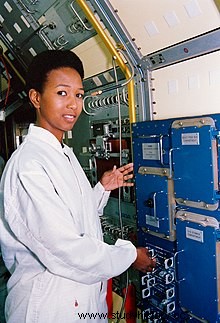Mae Jemison (born 1956) is an American astronaut and engineer. In 1992, aboard the space shuttle Endeavour , she is the first black woman to go into space.
Women astronauts
 Youngest daughter of Dorothy Green, an English and math teacher, and Charlie Jemison, an employee at a charity organization, Mae Carol Jemison was born on October 17, 1956 in Decatur, Alabama (United States). When she was three years old, her parents decided to move to Chicago to provide their children with better educational opportunities.
Youngest daughter of Dorothy Green, an English and math teacher, and Charlie Jemison, an employee at a charity organization, Mae Carol Jemison was born on October 17, 1956 in Decatur, Alabama (United States). When she was three years old, her parents decided to move to Chicago to provide their children with better educational opportunities.
From childhood, Mae dreams of traveling in space and shows a great interest in science. His parents support his passion, seizing the opportunities that arise to awaken his curiosity and his sense of experimentation. A strong-willed Mae, she is unfazed by those who suggest to her that science is not a female career. And when the Apollo 11 mission team sets foot on the moon, they get annoyed that they don't see female astronauts.
“Growing up…I was just like every other kid. I loved space, stars and dinosaurs. I always knew I wanted to explore. At the time of the Apollo airing, everybody was thrilled about space, but I remember being irritated that there were no women astronauts. People tried to explain that to me, and I did not buy it. »
(Growing up, I was like any kid. I loved space, stars, and dinosaurs. I always knew I wanted to explore. During the mission broadcast Apollo, everyone was excited about space, but I remember being irritated that there were no female astronauts, they tried to explain it to me, but I wasn't convinced .)
Studies at Stanford
Mae Jemison does not have just one passion. She also loves dancing and takes a wide variety of lessons, from African dance to jazz, ballet and modern dance. Alongside her interest in science and space, she dreams of becoming a professional dancer. At 14, she auditioned for the role of Maria in West Side Story; she is not retained but obtains a role of dancer.
Passionate about art and science, Mae must choose a career. Her mother encourages her to become a doctor, explaining that she will be able to continue dancing. At 16, she entered Stanford University. His years of study were not easy; racism and sexism are a constant problem there and some teachers and students are not kind to her. Her assertive and self-confident character helped her get through these years, and in 1977 she obtained an engineering degree in chemical engineering and then a medical degree in 1981.
After graduating, Mae joined the Peace Corps and served there for two years as a volunteer physician in Liberia and Sierra Leone.
Aboard the Endeavour
In 1983, Sally Ride was the first American woman in space. Mae Jemison concludes that the astronaut recruitment program opens and applies in 1983 and then in 1987. She is then selected with fourteen other candidates, among approximately 2,000 applicants. She was one of the first recruits after the Challenger shuttle accident in 1986, during which seven astronauts died.
Within NASA, Mae works with the Kennedy Space Center in Florida, on the launch of the first shuttles after the accident of Challenger . In September 1992, she took part, as a mission specialist, in the STS-47 mission. Aboard the Endeavour , Mae becomes the first black woman in space, and takes with her a photo of Bessie Coleman, the first black woman to earn a pilot's license. During the mission, she conducts several experiments, notably on weightlessness and motion sickness.
“The first thing I saw from space was Chicago, my hometown. (…) It was such a significant moment because since I was a little girl I had always assumed I would go into space. »
(The first thing I saw from space was Chicago, my hometown. (…) It was a very important moment because since I was a little girl , I always thought I would go to space)

Science projects
Mae Jemison resigned from NASA in 1993 to found her own company, The Jemison Group, to conduct research and develop science and technology for everyday life. In honor of her mother, she also created the Dorothy Jemison Foundation. One of the projects of his foundation, The Earth We Share , offers an international science camp where young people aged 12 to 16 work to solve current global problems.
At the same time, Mae took up a professorship in environmental sciences at Dartmouth College. An active member of various scientific organizations, she works to encourage a taste for science among students from minorities.
Besides her teaching activities, Mae also works on research and development projects on the nervous system in particular.
Mae Jemison is enshrined in the National Hall of Fame.
